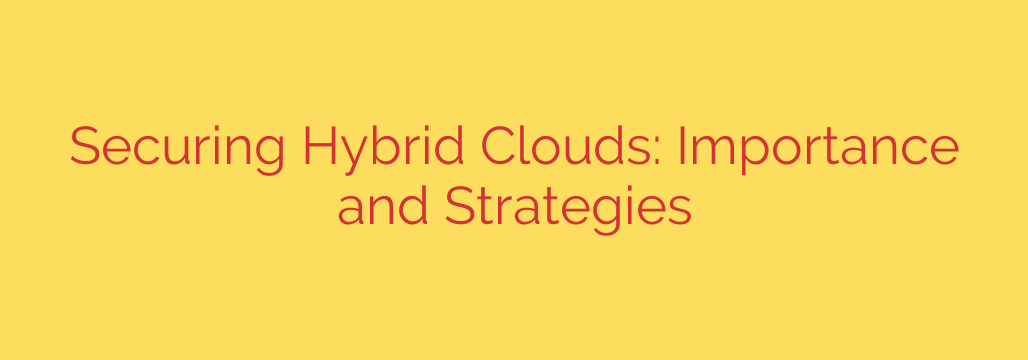
Mastering Hybrid Cloud Security: A Practical Guide for Modern Enterprises
The move to a hybrid cloud environment—blending on-premises private clouds with public cloud services—offers businesses unparalleled flexibility, scalability, and efficiency. However, this distributed architecture also introduces significant security challenges. Managing security across different platforms, each with its own protocols and tools, can create dangerous visibility gaps and inconsistencies.
Successfully navigating this landscape requires a proactive and unified security strategy. Protecting your data and infrastructure in a hybrid model isn’t just about deploying tools; it’s about building a cohesive security framework that spans all your environments.
The Unique Challenges of Hybrid Cloud Security
Before diving into solutions, it’s crucial to understand why securing a hybrid cloud is fundamentally different from traditional on-premises or pure public cloud security.
- Expanded Attack Surface: Your security perimeter is no longer a single, well-defined boundary. It’s a fluid line that stretches from your data center to one or more public cloud providers. This creates more potential entry points for malicious actors.
- Inconsistent Security Policies: Applying a consistent set of security rules and compliance standards across diverse environments is a major hurdle. What works for your private cloud might not be directly applicable or available in a public cloud, leading to policy gaps.
- Lack of Centralized Visibility: Without the right tools, gaining a single, comprehensive view of your entire infrastructure is nearly impossible. Security teams often struggle to monitor traffic and detect threats that move between private and public clouds. This fragmentation can blind you to sophisticated, multi-stage attacks.
- Complex Compliance and Governance: Meeting regulatory requirements like GDPR, HIPAA, or PCI DSS becomes more complicated when data resides in multiple locations with different legal jurisdictions. Proving compliance requires meticulous tracking and reporting across all environments.
Core Strategies for a Resilient Hybrid Cloud Defense
To overcome these challenges, organizations must adopt a strategic approach focused on integration, automation, and proactive defense. Here are the core strategies for building a robust hybrid cloud security posture.
1. Adopt a Unified Security Management Approach
Managing disparate security tools for each environment is inefficient and risky. The solution is to implement a Cloud Security Posture Management (CSPM) or similar platform that provides a “single pane of glass” view.
A unified platform allows you to monitor configurations, detect misconfigurations, and enforce security policies consistently across all your cloud and on-premise assets. This centralized visibility is the foundation of effective hybrid security, enabling your team to spot anomalies and respond faster.
2. Implement Strong Identity and Access Management (IAM)
In a distributed environment, identity is the new perimeter. A robust IAM strategy is non-negotiable. This involves enforcing the principle of least privilege, ensuring that users and applications only have the access permissions they absolutely need to perform their functions.
Implement Multi-Factor Authentication (MFA) everywhere possible and use centralized identity providers to manage credentials across your entire hybrid ecosystem. Regularly audit user permissions and revoke unnecessary access promptly to minimize the risk of compromised accounts.
3. Prioritize End-to-End Data Encryption
Your data is your most valuable asset, and it must be protected wherever it is. This means implementing strong encryption for data both at rest (stored on servers or in databases) and in transit (moving between your on-premise data center and the public cloud).
Manage your encryption keys carefully using a centralized key management system. This ensures you maintain control over your data, even when it’s stored on a public cloud provider’s infrastructure.
4. Secure the Network with a Zero Trust Model
The traditional “castle-and-moat” security model is obsolete in a hybrid world. Instead, adopt a Zero Trust architecture, which operates on the principle of “never trust, always verify.”
This means every access request must be authenticated, authorized, and encrypted, regardless of whether it originates from inside or outside your network. Utilize micro-segmentation to divide your network into small, isolated zones to prevent lateral movement by attackers. If one segment is breached, the damage is contained and cannot easily spread to other parts of your infrastructure.
5. Automate Compliance and Threat Response
Manually managing compliance and responding to security alerts across a hybrid environment is not scalable. Automation is key to maintaining a strong and consistent security posture.
Use automated tools to continuously scan for compliance deviations and misconfigurations, providing real-time alerts. Furthermore, leverage Security Orchestration, Automation, and Response (SOAR) platforms to automate routine threat responses. This frees up your security professionals to focus on more complex threats while ensuring that common issues are remediated instantly.
Actionable Security Tips for Your Hybrid Cloud
- Understand the Shared Responsibility Model: Clearly define which security tasks are handled by your public cloud provider and which are your responsibility. This varies by provider and service, so review the terms carefully.
- Conduct Regular Security Audits: Proactively perform audits and penetration tests across all your environments to identify and fix vulnerabilities before they can be exploited.
- Maintain Comprehensive Logging and Monitoring: Aggregate logs from all your on-premise and cloud environments into a central Security Information and Event Management (SIEM) system for holistic threat analysis.
- Train Your Team: Ensure your IT and security teams are well-versed in the specific security tools and best practices for each cloud platform you use.
By embracing these strategies, your organization can harness the power and agility of the hybrid cloud without sacrificing security. A well-secured hybrid environment is not an impenetrable fortress but a resilient, adaptable ecosystem designed to detect, contain, and respond to threats effectively.
Source: https://www.horizoniq.com/blog/hybrid-cloud-security/








